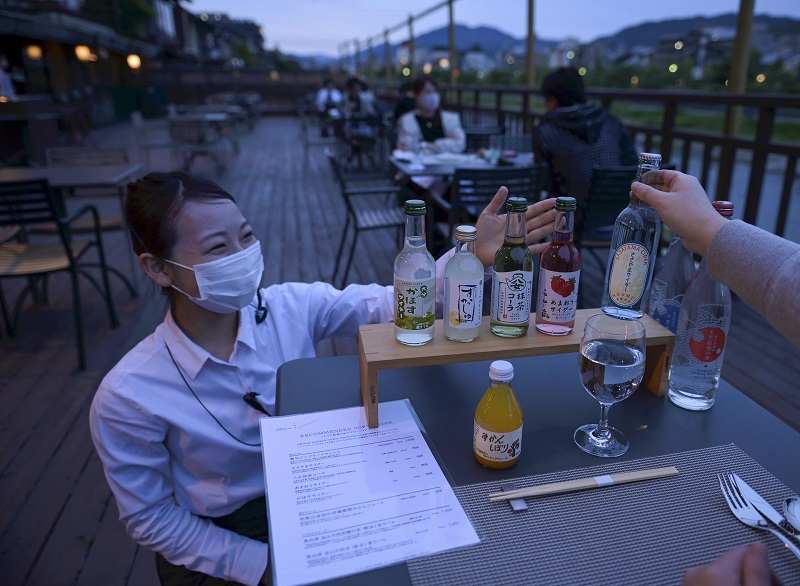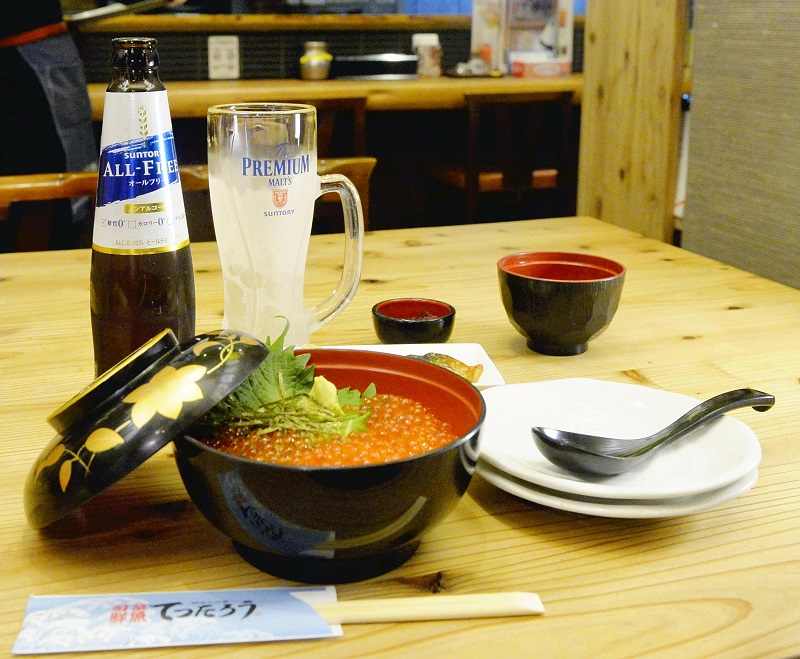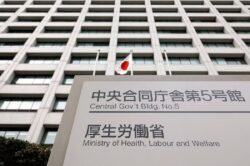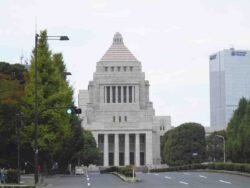
A restaurant in Shimogyo Ward, Kyoto, offers five kinds of ciders from around the nation.
13:02 JST, June 8, 2021
OSAKA — While many restaurants had no choice but to close their doors after being asked to stop serving alcoholic beverages during the third state of emergency, others have tried to make do with nonalcoholic beverages as means of surviving the pandemic.
In a search for ways to attract customers, menus are being expanded. “We want to create an atmosphere that people can enjoy without alcohol,” a restaurant owner said.
Doubling product lineup
Nonalcoholic beverages are manufactured to look and taste like beer, chuhai soda, shochu mixed with water, and other alcoholic beverages. Many are labeled as having an alcohol content of 0.00%, though beverages with less than 1% alcohol are not defined as alcoholic drinks under the Liquor Tax Law. Under the Food Sanitation Law, they are classified as soft drinks.
After the third state of emergency was declared, Itameshiya 8, an Italian restaurant in Osaka’s Kita Ward, displayed a poster that read, “Feel tipsy without alcohol!” to promote nonalcoholic beverages.
On April 25, the first day of the state of emergency, the restaurant changed its business hours to close at 8 p.m. and increased its lineup of nonalcoholic beverages from seven to 14 in place of alcoholic drinks.
During the first state of emergency, the restaurant closed its doors and lost many customers.
Reflecting on what happened, the restaurant decided to stay open this time.
At first, some customers passed by after learning that the restaurant did not serve wine.
However, orders for nonalcoholic beverages gradually increased, and within two weeks after the start of the third state of emergency, orders tripled compared to previous years. “Operation is not easy, but we want to keep the restaurant going by providing nonalcoholic drinks,” said Masatsugu Mitani, the sales manager at the restaurant’s operating company.
Tetsutaro Umeda Nakazaki-cho, an izakaya Japanese style pub also in Kita Ward, is offering a set that includes a nonalcoholic beer with a chilled glass, salmon roe rice bowl and miso soup for ¥1,000. “Since we can’t serve alcohol, we have to do something to combat the situation,” owner Takayuki Yanagawa said.
French restaurant Le Un Funatsuru Kyoto Kamogawa Resort is known for its terrace called “noryo-yuka,” or cooling floor, which sits above the bank of the Kamogawa river in Kyoto. The restaurant is gambling with soft drinks by providing five kinds of ciders from around the nation for the first time, in addition to nonalcoholic beer and other beverages.
Yumi Kumazawa, manager of the restaurant, hopes that the soft drinks will make people feel like they have traveled around the country.

An eatery in Kita Ward, Osaka, serves a set menu that includes a nonalcoholic beer.
Expanding shipments
Manufacturers are also scrambling to respond to the growing demand for nonalcoholic drinks. Kirin Brewery Co. increased its production of beverages of this kind in May by about 10% compared to the same month last year. Immediately after the state of emergency was declared, shipments of its Zero Ichi nonalcoholic beer surged, mainly to restaurants.
Asahi Breweries Ltd. also increased shipments of its Dry Zero nonalcoholic beer.
Since the latest state of emergency came into effect, Tokyo-based liquor sales chain operator Kakuyasu Group Co. has seen an increase in orders for nonalcoholic drinks, mainly from privately owned taverns.
“The demand has increased, but many establishments are still having a hard time running their businesses because the amount of nonalcoholic beverages consumed is not that large compared to alcohol,” a Kakuyasu official said.
Noncooperative businesses
There are many restaurants ignoring local government requests to refrain from serving alcoholic beverages. In the downtown area of Osaka, where many businesses are closed, some establishments brazenly display signs that read, “All you can drink,” and some restaurant employees try to attract people by showing their liquor menus to passersby.
“A bar is a place that serves alcohol. If we only serve nonalcoholic beverages, the business is not viable,” said the manager of a bar that continues to operate in Osaka’s Minami district.
“There is a high risk of mass infection occurring in restaurants, so we would like their cooperation,” an Osaka prefectural government official said.
"Society" POPULAR ARTICLE
-

M4.9 Earthquake Hits Tokyo, Neighboring Prefectures
-

M7.5 Earthquake Hits Northern Japan; Tsunami Waves Observed in Hokkaido, Aomori and Iwate Prefectures
-

Tsukiji Market Urges Tourists to Avoid Visiting in Year-End
-

Beloved Cat Stationmaster Nitama in Wakayama Pref. Passes Away at 15
-

M5.7 Earthquake Hits Japan’s Kumamoto Pref., Measuring Upper 5 Intensity, No Tsunami Expected
JN ACCESS RANKING
-

Japan’s Hopes for Seafood Exports Shot Down in China Spat
-

Keidanren Chairman Yoshinobu Tsutsui Visits Kashiwazaki-Kariwa Nuclear Power Plant; Inspects New Emergency Safety System
-

Japan to Charge Foreigners More for Residence Permits, Looking to Align with Western Countries
-

Japan Exports Rise in October as Slump in U.S. Sales Eases
-

Govt Aims to Expand NISA Program Lineup, Abolish Age Restriction

























